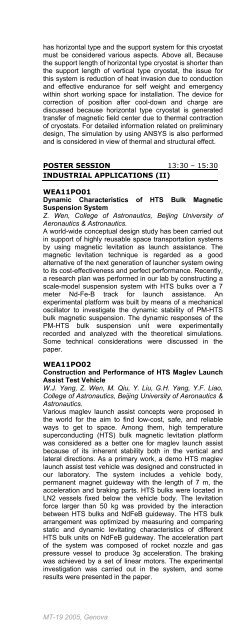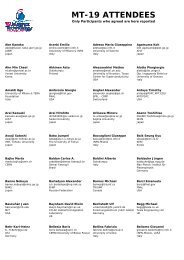Click here to download the abstract booklet in pdf format - MT19 - Infn
Click here to download the abstract booklet in pdf format - MT19 - Infn
Click here to download the abstract booklet in pdf format - MT19 - Infn
Create successful ePaper yourself
Turn your PDF publications into a flip-book with our unique Google optimized e-Paper software.
has horizontal type and <strong>the</strong> support system for this cryostat<br />
must be considered various aspects. Above all, Because<br />
<strong>the</strong> support length of horizontal type cryostat is shorter than<br />
<strong>the</strong> support length of vertical type cryostat, <strong>the</strong> issue for<br />
this system is reduction of heat <strong>in</strong>vasion due <strong>to</strong> conduction<br />
and effective endurance for self weight and emergency<br />
with<strong>in</strong> short work<strong>in</strong>g space for <strong>in</strong>stallation. The device for<br />
correction of position after cool-down and charge are<br />
discussed because horizontal type cryostat is generated<br />
transfer of magnetic field center due <strong>to</strong> <strong>the</strong>rmal contraction<br />
of cryostats. For detailed <strong>in</strong><strong>format</strong>ion related on prelim<strong>in</strong>ary<br />
design, The simulation by us<strong>in</strong>g ANSYS is also performed<br />
and is considered <strong>in</strong> view of <strong>the</strong>rmal and structural effect.<br />
POSTER SESSION 13:30 – 15:30<br />
INDUSTRIAL APPLICATIONS (II)<br />
WEA11PO01<br />
Dynamic Characteristics of HTS Bulk Magnetic<br />
Suspension System<br />
Z. Wen, College of Astronautics, Beij<strong>in</strong>g University of<br />
Aeronautics & Astronautics.<br />
A world-wide conceptual design study has been carried out<br />
<strong>in</strong> support of highly reusable space transportation systems<br />
by us<strong>in</strong>g magnetic levitation as launch assistance. The<br />
magnetic levitation technique is regarded as a good<br />
alternative of <strong>the</strong> next generation of launcher system ow<strong>in</strong>g<br />
<strong>to</strong> its cost-effectiveness and perfect performance. Recently,<br />
a research plan was performed <strong>in</strong> our lab by construct<strong>in</strong>g a<br />
scale-model suspension system with HTS bulks over a 7<br />
meter Nd-Fe-B track for launch assistance. An<br />
experimental platform was built by means of a mechanical<br />
oscilla<strong>to</strong>r <strong>to</strong> <strong>in</strong>vestigate <strong>the</strong> dynamic stability of PM-HTS<br />
bulk magnetic suspension. The dynamic responses of <strong>the</strong><br />
PM-HTS bulk suspension unit were experimentally<br />
recorded and analyzed with <strong>the</strong> <strong>the</strong>oretical simulations.<br />
Some technical considerations were discussed <strong>in</strong> <strong>the</strong><br />
paper.<br />
WEA11PO02<br />
Construction and Performance of HTS Maglev Launch<br />
Assist Test Vehicle<br />
W.J. Yang, Z. Wen, M. Qiu, Y. Liu, G.H. Yang, Y.F. Liao,<br />
College of Astronautics, Beij<strong>in</strong>g University of Aeronautics &<br />
Astronautics.<br />
Various maglev launch assist concepts were proposed <strong>in</strong><br />
<strong>the</strong> world for <strong>the</strong> aim <strong>to</strong> f<strong>in</strong>d low-cost, safe, and reliable<br />
ways <strong>to</strong> get <strong>to</strong> space. Among <strong>the</strong>m, high temperature<br />
superconduct<strong>in</strong>g (HTS) bulk magnetic levitation platform<br />
was considered as a better one for maglev launch assist<br />
because of its <strong>in</strong><strong>here</strong>nt stability both <strong>in</strong> <strong>the</strong> vertical and<br />
lateral directions. As a primary work, a demo HTS maglev<br />
launch assist test vehicle was designed and constructed <strong>in</strong><br />
our labora<strong>to</strong>ry. The system <strong>in</strong>cludes a vehicle body,<br />
permanent magnet guideway with <strong>the</strong> length of 7 m, <strong>the</strong><br />
acceleration and brak<strong>in</strong>g parts. HTS bulks were located <strong>in</strong><br />
LN2 vessels fixed below <strong>the</strong> vehicle body. The levitation<br />
force larger than 50 kg was provided by <strong>the</strong> <strong>in</strong>teraction<br />
between HTS bulks and NdFeB guideway. The HTS bulk<br />
arrangement was optimized by measur<strong>in</strong>g and compar<strong>in</strong>g<br />
static and dynamic levitat<strong>in</strong>g characteristics of different<br />
HTS bulk units on NdFeB guideway. The acceleration part<br />
of <strong>the</strong> system was composed of rocket nozzle and gas<br />
pressure vessel <strong>to</strong> produce 3g acceleration. The brak<strong>in</strong>g<br />
was achieved by a set of l<strong>in</strong>ear mo<strong>to</strong>rs. The experimental<br />
<strong>in</strong>vestigation was carried out <strong>in</strong> <strong>the</strong> system, and some<br />
results were presented <strong>in</strong> <strong>the</strong> paper.<br />
WEA11PO03<br />
Applications of Low Temperature, AC<br />
Superconduct<strong>in</strong>g Magnets for Material Process<strong>in</strong>g<br />
H. Kasahara, CRIEPI; S. Taniguchi, K. Ueno, Tohoku<br />
University; S-I. Shimazaki, JST.<br />
We did a fundamental exam<strong>in</strong>ation of an application for<br />
materials process<strong>in</strong>g us<strong>in</strong>g AC superconduct<strong>in</strong>g magnets.<br />
Us<strong>in</strong>g AC magnets, applied two axis movement magnetic<br />
fields, and stir<strong>in</strong>g melted metals. It can generate a high<br />
density alloy. To applicate AC Superconduc<strong>to</strong>r, it is<br />
necessary that (1) <strong>the</strong>rmal <strong>in</strong>sulation technology, (2)<br />
optimiz<strong>in</strong>g of magnet shapes, and (3) optimizarion of a<br />
magnet driv<strong>in</strong>g conditions. In this paper, we present a basic<br />
exam<strong>in</strong>ation results.<br />
WEA11PO04<br />
The numerical analysis of magnetic stiffness <strong>in</strong> a<br />
magnetic levitation<br />
X. Wang, S. Wang, J. Wang, H. Song, J. Zheng, Southwest<br />
Jiao<strong>to</strong>ng University.<br />
A two-dimensional numerical analysis, tak<strong>in</strong>g <strong>the</strong> voltagecurrent<br />
power-law characteristic of <strong>the</strong> high temperature<br />
superconduc<strong>to</strong>r <strong>in</strong><strong>to</strong> account, was proposed <strong>to</strong> calculate<br />
<strong>the</strong> associated stiffness on a YBCO bulk superconduc<strong>to</strong>r<br />
above a permanent magnet guideway when small<br />
movements were produced. The dependence of stiffness<br />
matrix upon <strong>the</strong> different field cool<strong>in</strong>g position was<br />
extensively studied based on <strong>the</strong> f<strong>in</strong>ite element <strong>the</strong>ory.<br />
Additionally, <strong>the</strong> numerical technology discussed <strong>the</strong><br />
<strong>in</strong>fluence of <strong>the</strong> iron surround<strong>in</strong>g <strong>the</strong> permanent magnet,<br />
which is beneficial <strong>to</strong> <strong>the</strong> design and optimization of <strong>the</strong><br />
high temperature superconduc<strong>to</strong>r Maglev system<br />
WEA11PO05<br />
The effect of magnetic force on oxygen bubble dur<strong>in</strong>g<br />
<strong>the</strong> oxide crystal growth<br />
J. Park, T. Shimomura, M. Yamanaka, S. Watauchi, I.<br />
Tanaka, Center for Science and Technology, University of<br />
Yamanashi; K. Kishio, The University of Tokyo.<br />
Oxygen bubble <strong>in</strong> a crystal is <strong>in</strong>evitable dur<strong>in</strong>g a<br />
conventional float<strong>in</strong>g zone (FZ) growth of calcium<br />
alum<strong>in</strong>ate (Ca12Al7O33; C12A7), a newly remarkable<br />
material as a transparent electrical conduc<strong>to</strong>r. We<br />
<strong>in</strong>vestigated <strong>the</strong> effects of magnetic force on <strong>the</strong> behavior<br />
of oxygen bubbles dur<strong>in</strong>g crystal growth of C12A7 because<br />
of <strong>the</strong> extreme large paramagnetism of oxygen. For <strong>the</strong><br />
crystal growth of C12A7 under magnetic field, <strong>the</strong> FZ<br />
furnace is specially designed and <strong>in</strong>stalled with a<br />
superconduct<strong>in</strong>g magnet. In this furnace, <strong>the</strong> size of melt<br />
for <strong>the</strong> crystal growth is small and <strong>the</strong> melt position is<br />
variable along <strong>the</strong> magnet bore; t<strong>here</strong>fore, <strong>the</strong> direction of<br />
<strong>the</strong> magnetic force is changeable by <strong>the</strong> growth position. In<br />
this study, C12A7 crystals were grown at two different<br />
positions, w<strong>here</strong> <strong>the</strong> magnetic force <strong>to</strong> oxygen bubbles<br />
works upward and downward, respectively. In <strong>the</strong> growth<br />
condition when magnetic force was upward, <strong>the</strong> grown<br />
crystals were half transparent and half opaque due <strong>to</strong> <strong>the</strong><br />
segregation of oxygen bubbles. The number of <strong>the</strong><br />
segregated bubbles was reduced as <strong>the</strong> applied magnetic<br />
force was <strong>in</strong>creased. On <strong>the</strong> o<strong>the</strong>r hands, <strong>the</strong> crystals<br />
grown under <strong>the</strong> downward magnetic force were<br />
transparent under higher magnetic field than 5T. Our<br />
results show that <strong>the</strong> behavior of oxygen bubbles can be<br />
controlled by magnetic force even over 1392 degree of<br />
Celsius, <strong>the</strong> melt<strong>in</strong>g po<strong>in</strong>t of C12A7 and that <strong>the</strong> downward<br />
magnetic force is effective <strong>to</strong> obta<strong>in</strong> transparent C12A7<br />
crystals.<br />
MT-19 2005, Genova 110



